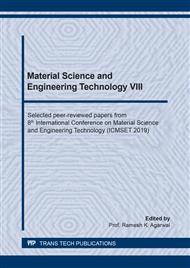[1]
C.A. Andrade-Tacca, C.C. Chang, Y.H. Chen, D.V. Manh, C.Y. Chang, D.R. Ji, J.Y. Tseng and J.L. Shie: Esterification of Jatropha Oil via Ultrasonic Irradiation with Auto-induced Temperature-rise Effect, Energy Vol. 71 (2014), pp.346-354.
DOI: 10.1016/j.energy.2014.04.066
Google Scholar
[2]
T. Vanichseni, S. Intaravichai, B. Saitthiti and T. Kiatiwat: Potential Biodiesel Production from Palm Oil for Thailand, Kasetsart J. Vol. 23 (2002), pp.83-97.
Google Scholar
[3]
S. Preechajarn, P. Prasertsri: This Report Contains Assessments of Commodity and Trade Issues Made by USDA Staff and Not Necessarily Statements of Official U.S. Government Policy, USDA Foreign Agricultural Service: Washington, DC, USA (2018), pp.1-14.
Google Scholar
[4]
R.M. Ail, H.A. Farag, N.A. Amin and I.H. Farag: Phosphate Rock Catalyst for Biodiesel Production from Waste Frying Oil, Jokull Journal Vol. 65 (2015), pp.233-244.
Google Scholar
[5]
F. Jalal, P.S. Ilavarasi and L.R. Miranda: Fatty Methyl Ester from Vegetable Oils for Use as A Diesel Fuel, IEEE first conference on clean energy and Technology CET (2011), pp.125-128.
DOI: 10.1109/cet.2011.6041472
Google Scholar
[6]
S.T. Keera, S.M. Sabagh and A.R. Taman: Transesterification of Vegetable Oil to Biodiesel Fuel Using Alkaline Catalyst, Fuel Vol. 90 (2011), pp.42-47.
DOI: 10.1016/j.fuel.2010.07.046
Google Scholar
[7]
K. Wijitsopa, K. Somnuk, T. Theppaya, and G. Prateepchaikul: Continuous Transesterification for Ethyl Ester Production from Refined Palm Oil through Static Mixer, Appl. Mech. Mater. Vol. 705 (2015), pp.64-68.
DOI: 10.4028/www.scientific.net/amm.705.64
Google Scholar
[8]
A. Bokhari, L.F. Chuah, S. Yusup, J.J. Klemes, M.M. Akbar and R.N.M. Kamil: Cleaner Production of Rubber Seed Oil Methyl Ester Using A Hydrodynamic Cavitation: Optimization and Parametric Study, J. Clean. Prod. Vol. 136 (2016), pp.31-41.
DOI: 10.1016/j.jclepro.2016.04.091
Google Scholar
[9]
Information on https://www.mecholic.com/2018/06/application-advantages- cavitation.html.
Google Scholar
[10]
V.K. Saharan, M.A. Rizwani, A.A. Malani and A.B. Pandit: Effect of geometry of hydrodynamically cavitating device on degradation of orange-G, Ultrason. Sonochem. Vol. 20 (2013), pp.345-353.
DOI: 10.1016/j.ultsonch.2012.08.011
Google Scholar
[11]
P.R. Gogate and B.P. Aniruddha: A Review and Assessment of Hydrodynamic Cavitation as a Technology for the Future, Ultrason. Sonochem. Ninth Conference of the European Society of Sonochemistry Vol. 12 (2005), pp.21-27.
Google Scholar
[12]
P.R. Gogate and B.P. Aniruddha: Hydrodynamic Cavitation Reactors: A State of the Art Review, Rev. Chem. Eng. Vol. 17 (2011), pp.1-85.
Google Scholar
[13]
A. Bokhari, L.F. Chuah, S. Yusup, J. J. Klemes, M. M. Akbar and R.N.M. Kamil: Cleaner Production of Rubber Seed Oil Methyl Ester Using A Hydrodynamic Cavitation: Optimisation and Parametric Study, J. Clean. Prod. Vol. 136 (2016), pp.31-41.
DOI: 10.1016/j.jclepro.2016.04.091
Google Scholar
[14]
A. Pal, A. Verma, S.S. Kachhwaha and S. Maji: Biodiesel Production through Hydrodynamic Cavitation and Performance Testing, Renew. Energ. Vol. 35 (2010), pp.619-624.
DOI: 10.1016/j.renene.2009.08.027
Google Scholar
[15]
L.F. Chuah, J.J. Klemes, S. Yusup, A. Bokhari, M.M. Akbar and Z.K. Chong: Kinetic Studies on Waste Cooking Oil into Biodiesel via Hydrodynamic Cavitation, J. Clean. Prod. Vol. 146 (2017), pp.47-56.
DOI: 10.1016/j.jclepro.2016.06.187
Google Scholar
[16]
K. Somnuk, T. Prasit and G. Prateepchaikul: Effects of Mixing Technologies on continous Methyl Ester Production: Comparison of Using Plug Flow, Static Mixer, and Ultrasound Clamp, Energ. Convers. Manage. Vol. 140 (2017), pp.91-97.
DOI: 10.1016/j.enconman.2017.02.066
Google Scholar
[17]
K. Somnuk, T. Prasit, D. Phanyusoh, and G. Prateepchaikul: Continuous methyl ester production with low frequency ultrasound clamps on a tubular reactor, Biofuels (2018), pp.1-7.
DOI: 10.1080/17597269.2018.1510722
Google Scholar
[18]
N. Serpone and P. Colarusso: Sonochemistry I. Effcts of Ultrasounds on Heterogenous Chemical Reaction- A Useful Tool to Generate Radicals and Examine Reaction Mechanisms, Res. Chem. Intermed. Vol. 20 (1999), pp.635-679.
DOI: 10.1163/156856794x00261
Google Scholar
[19]
Information on https://en.wikipedia.org/wiki/Polylactic_acid.
Google Scholar
[20]
Information on https://en.wikipedia.org/wiki/Acrylonitrile_butadiene_styrene.
Google Scholar
[21]
M.G.M. Lopes, H.S. Santana, V. F. Andophato, F.N. Russo, J.L.S. Jr and O.P. Taranto: 3D printed micro-chemical plant for biodiesel synthesis in millireactors, Energ. Convers. Manage. Vol. 184 (2019), pp.475-487.
DOI: 10.1016/j.enconman.2019.01.090
Google Scholar


